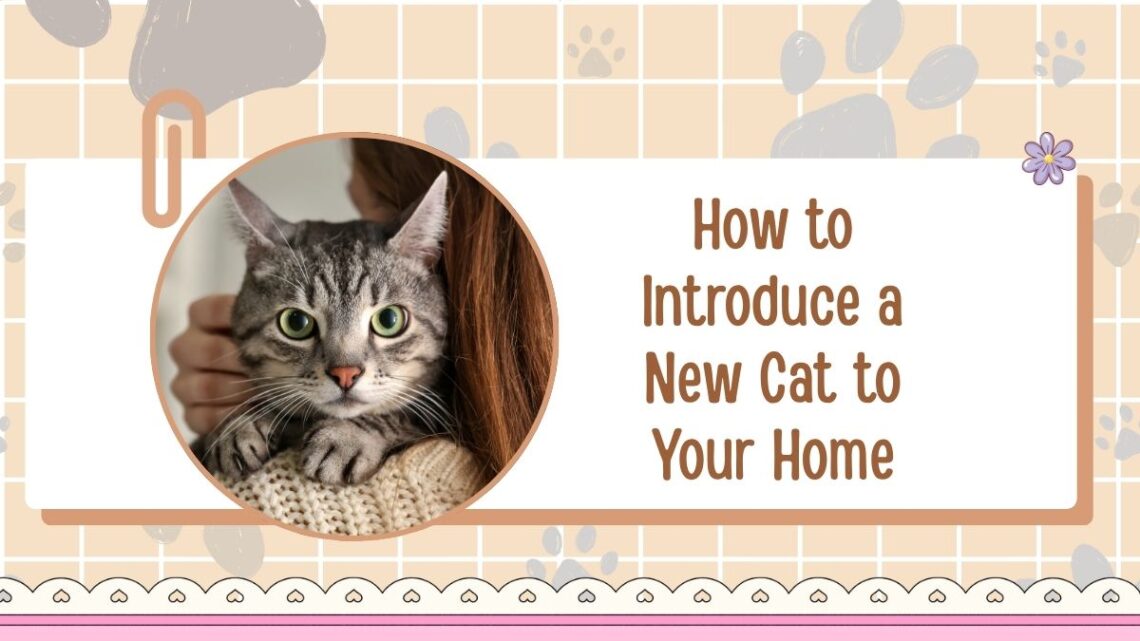Cats are territorial, scent-driven animals. A gradual, structured introduction dramatically lowers stress, reduces conflict injuries, and helps prevent long-term issues like inappropriate elimination or food guarding.
Modern feline guidelines emphasize meeting environmental needs (separate core resources, predictability, control/choice) to protect physical and emotional health.
Pre-Arrival Prep (48–72 Hours Before)
1) Create a “Base Camp” room
Choose a quiet, ventilated room with a closable door (bedroom/bathroom). Equip it with separate resources: food/water, a litter box, bed/hiding box, scratching surface, toys, and a vertical perch or shelf.
Provide one litter box per cat plus one extra for the home (e.g., 2 cats = 3 boxes) and place boxes in different, easily accessible locations.
2) Duplicate everything
Each cat should have its own food station, water, litter box, resting spot, and scratching post. This reduces competition and anxiety from day one.
3) Consider pheromone support
Many behavior protocols include feline synthetic pheromone diffusers started 24–48 hours before arrival—one in the main living area and one in the transition room—to promote a calmer environment.
4) Health & safety check
Schedule a first-week vet exam, update vaccinations, and bring records if adopting. Plan for a short quarantine/observation (see next section) to protect resident pets from stress-triggered upper respiratory infections (URIs) common after relocation.
Days 0–3 (Complete Separation + Quarantine)
Goal: Allow your new cat to decompress and feel safe while you gather baseline info (appetite, litter habits, temperament).
- Door-closed isolation in Base Camp for 3–7 days (some shelters advise 7–10 days, others 10–14 days, especially for strays/shelter cats). Adjust within this range based on appetite, stool quality, and absence of URI signs (eye/nasal discharge, sneezing).
- Keep hands-off meetings. Let cats sniff under the door and investigate scent articles (see next step).
- Maintain a predictable routine (feeding, play, litter scooping) to communicate safety and control.
Days 2–5 (Scent Swapping & Positive Associations)
Scent is everything for cats. Start building “family smell” before visual contact:
- Sock/cloth rubs: Gently rub cheeks/chin/neck of each cat with separate soft cloths or socks and swap them between rooms. Pair exposure with treats or play to create positive associations with the other cat’s scent. Repeat 2–3× daily.
- Bedding/resource rotation: Exchange beds, small blankets, and scratch pads every day.
- Watch for calm curiosity (sniffing, relaxed body) versus defensive signals (flat ears, growl). Only proceed when both cats remain relaxed around swapped scents for 24–48 hours.
Days 4–7 (Site Swaps & Mealtime Desensitization)
Now gently blend territories without direct viewing:
- Site swaps: Temporarily move the newcomer (in a carrier) to a bathroom while the resident cat explores the Base Camp; then let the new cat roam supervised in the main home. Rotate daily. This equalizes scent distribution and reduces “home field” defensiveness.
- Feed on opposite sides of the door. Start bowls a few feet away from the closed door, then gradually move them closer across sessions as both cats remain relaxed. The goal: other-cat scent/noise + good things (food).
Days 7–10 (Cracked Door, Gate, Or Screen — First Visuals)
Controlled, low-stakes viewing comes next:
- Barrier intros: Use a baby gate, screen, or a door opened just an inch with a stopper so cats can see and smell but not cross. Offer high-value treats or wand-toy play on each side during short sessions (2–5 minutes), multiple times daily. End before arousal rises.
- Look for soft bodies, slow blinking, brief nose-air sniffs, or casual grooming. If you see piloerection, fixed staring, or growling, increase distance/time and return to scent swap for another day.
Days 10–14 (Short, Supervised, No-Barrier Hellos)
If barrier sessions stay calm for 24–48 hours:
- Conduct brief (3–5 min) face-to-face sessions in a neutral area. Keep two handlers if possible, one cat each, with wand toys and treat scatter to diffuse tension.
- Interrupt tension early with a toy redirect or gentle barrier placement—never punish; it associates the other cat with fear. End on a neutral or positive note.
- Gradually lengthen sessions and increase locations. If you get setbacks (hissing, swatting), back up a step for 24–72 hours, then retry shorter exposures.
Long-Term Harmony: Environment, Layout & Resource Math
Modern guidelines stress giving each cat choice and control over core resources to reduce conflict. Use this resource checklist to prevent competition:
Core Resource Rules
- Litter boxes: N + 1 (number of cats plus one), in multiple quiet, separate locations; large open boxes with low-dust litter often improve compliance.
- Feeding/water: Separate bowls out of line-of-sight; consider at least two feeding and two drinking stations per pair of cats.
- Resting & hiding: Provide two or more resting areas per cat or social group, including covered hideaways.
- Scratching & vertical space: Put multiple scratch options (horizontal + vertical) and vertical perches or shelves to create 3D space and escape routes.
- Pheromone support: Keep diffusers active for the first 3–4 weeks if helpful.
Step-By-Step Timeline & Setup At A Glance
| Phase | Duration (Typical) | What You Do | Green-Light Signs To Advance | If You See Stress… |
|---|---|---|---|---|
| Pre-Arrival | 48–72 hours | Prepare Base Camp; duplicate resources; start pheromone diffusers; book vet check | Calm environment ready; supplies duplicated | N/A |
| Quarantine & Separation | 3–7 days (up to 7–14 for shelter/stray) | Door-closed isolation; routine; monitor appetite/litter/URI signs | Eating, grooming, exploring Base Camp confidently | Extend separation; call vet if signs of illness |
| Scent Swaps | 2–3 days (overlap with above) | Swap bedding/socks; pair with treats/play | Relaxed response to other’s scent | Repeat swaps longer before advancing |
| Site Swaps & Door Feeding | 2–4 days | Site swaps; feed on opposite sides of door | Calm mealtimes near door; curiosity | Increase distance; revert to scent work |
| Visual Barrier Intros | 2–4 days | Baby gate/screen; short sessions with treats/play | Relaxed body; brief interest; slow blinks | Shorter sessions; more scent/site swaps |
| No-Barrier Supervised | 3–7 days | Brief, supervised hellos; toy redirects | Play in same room; coexistence | Back up to barrier stage 24–72 hrs |
| Full Integration | Ongoing | Maintain N+1 litter boxes, separate stations, vertical space | Shared calm, predictable routine | Reassess resource placement & routine |
Quarantine/separation durations vary by cat history and health; rescues commonly recommend 7–10 to 10–14 days to protect resident pets and reduce stress-related illness.
Reading Body Language & De-Escalation
Relaxed/curious: Soft eyes, upright tail tip, gentle sniffing, normal appetite.
Concerned: Crouch, tucked tail, ears sideways, hiding.
Escalated: Growling, hissing, fixed stare, piloerection, swatting.
De-escalation toolkit: End session early, increase distance, distract with a wand toy or treat scatter, and step back one stage for 1–3 days before retrying. This adheres to the “go at the pace of the most cautious cat” principle emphasized by feline behavior protocols.
Special Situations
Kittens to Adult Cats
Kittens have high energy; schedule two to three 10-minute play sessions daily (wand toys), then allow structured rest to avoid pestering the adult. Keep resource separation strict at first.
Multi-Cat Households
Think in social groups: litter-box math can be one per social group + one, but in most homes N+1 is simpler and protective. Ensure multiple vertical paths and “escape routes” to reduce corridor standoffs.
Small Apartments
Use vertical territory (shelves, trees), curtains or screens to create visual breaks, and micro-zones for food/water and rest. The principle is the same: separate, duplicate, distribute resources so cats can avoid each other when needed.
When To Seek Professional Help
If you see persistent aggression, resource guarding, or house-soiling, consult your veterinarian or a feline-focused behavior professional and revisit environmental needs and resource placement.
Putting It All Together: Your 14-Day Plan
- Days −2 to 0: Prepare Base Camp; start pheromones; gather supplies; schedule vet visit.
- Days 0–3(–7): Separation & quarantine; build routine; monitor health.
- Days 2–5: Scent swaps paired with treats/play.
- Days 4–7: Site swaps + feeding at the door; gradually reduce distance.
- Days 7–10: Visual barrier intros (gate/screen) in short, positive sessions.
- Days 10–14: Short, supervised, no-barrier hellos; extend as tolerance grows.
- Beyond Day 14: Maintain N+1 litter boxes, separate feeding stations, and vertical space; continue joint play/feeding to reinforce good associations.
A peaceful, permanent friendship starts with patience, structure, and great logistics. By preparing a Base Camp, duplicating and strategically placing resources, using scent and site swaps, and progressing through barrier-based visuals to supervised hellos, you’re aligning with the most up-to-date feline welfare guidance.
Keep routine steady, move at the pace of the more cautious cat, and maintain N+1 litter boxes, separate feeding/water stations, and vertical escape routes long term. This plan not only prevents early missteps but also sets the foundation for lifelong harmony—one calm, well-managed step at a time.
FAQs
Most pairs integrate over 2–4 weeks, but cautious or previously undersocialized cats may need longer. Always advance only after 24–48 hours of calm at each stage; setbacks mean stepping back one phase briefly.
They’re commonly included in veterinary behavior handouts and can help reduce tension when used alongside environmental and training steps. Start 24–48 hours pre-arrival and keep them on for 3–4 weeks while you work the plan.
Don’t punish or grab. Clap once, toss a soft barrier (towel/cardboard) between cats, or redirect with a wand toy. Return to separation, reinforce scent/site swaps for 24–72 hours, and retry shorter, calmer sessions. If aggression persists, contact your vet or a behavior professional.






